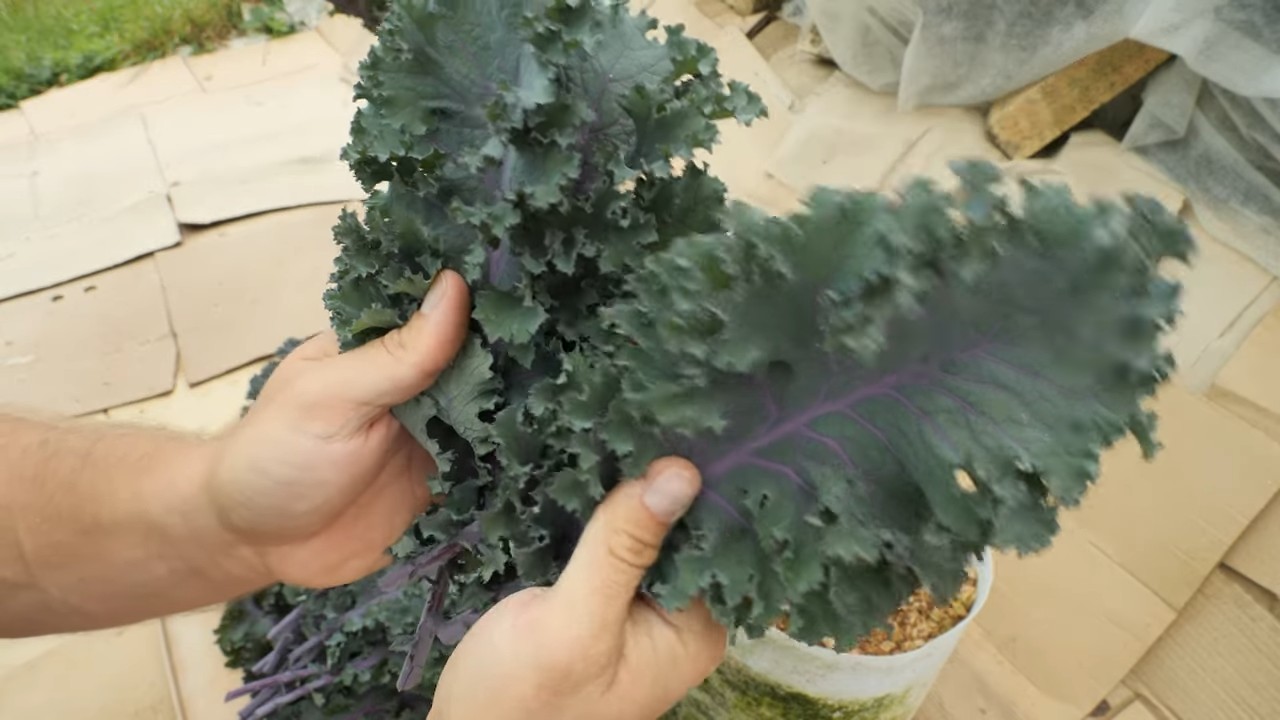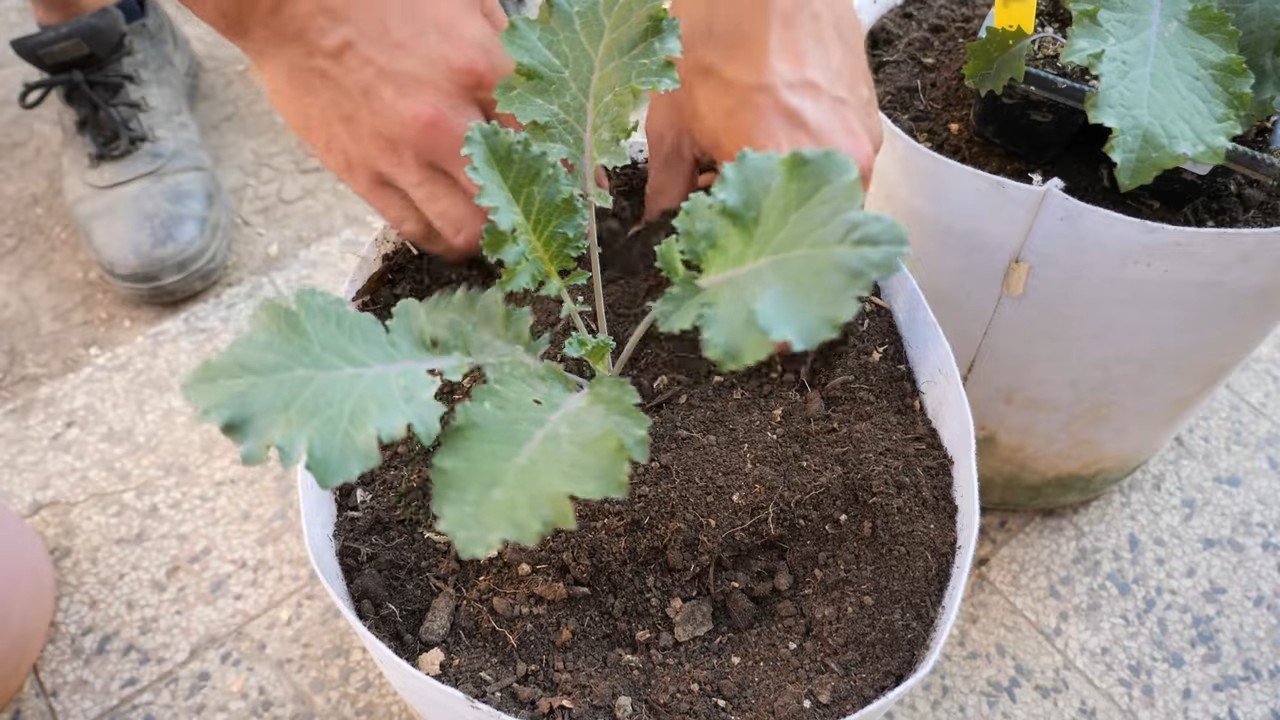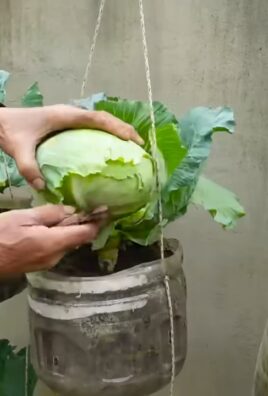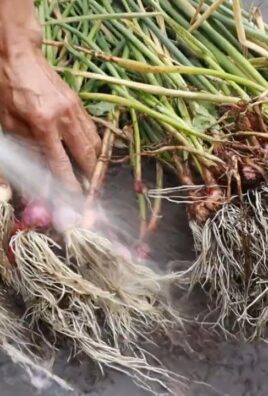Growing Kale in Containers: Unlock the secrets to a thriving, leafy green garden, even without a sprawling backyard! Have you ever dreamed of snipping fresh, vibrant kale leaves right outside your kitchen door? I know I have! This DIY guide is your passport to achieving just that. Forget the myth that you need acres of land to enjoy homegrown goodness. We’re about to dive into the wonderful world of container gardening, specifically focusing on the resilient and nutritious kale.
Kale, a nutritional powerhouse, has a rich history dating back to ancient Greece and Rome, where it was a staple food. Over centuries, it has journeyed across continents, becoming a beloved ingredient in diverse cuisines. But beyond its culinary appeal, growing your own kale offers a sense of connection to nature and a satisfying feeling of self-sufficiency.
In today’s fast-paced world, access to fresh, organic produce can be challenging and expensive. That’s where this DIY trick comes in! Growing Kale in Containers allows you to bypass the grocery store and cultivate your own supply of this superfood, ensuring you know exactly what goes into your food. Plus, it’s a fantastic way to add a touch of green to your balcony, patio, or even a sunny windowsill. So, let’s get our hands dirty and embark on this exciting gardening adventure together!

Growing Kale in Containers: A Beginner’s Guide
Hey there, fellow gardening enthusiasts! I’m so excited to share my experience with growing kale in containers. It’s surprisingly easy, even if you don’t have a huge backyard. Fresh, homegrown kale is so much tastier than anything you can buy at the store, and it’s packed with nutrients. Plus, it’s incredibly rewarding to watch those leafy greens thrive under your care. Let’s dive in!
Choosing the Right Container and Soil
Before we get our hands dirty, let’s talk about the essentials: the container and the soil. These are crucial for healthy kale growth.
* Container Size: Kale needs room to grow, so opt for a container that’s at least 12 inches in diameter and 12 inches deep. Bigger is generally better, as it allows for more root development and better water retention. I’ve had great success with 5-gallon buckets and large patio pots.
* Drainage: This is non-negotiable! Make sure your container has drainage holes at the bottom. Kale hates sitting in soggy soil, which can lead to root rot. If your container doesn’t have drainage holes, you can drill some yourself.
* Material: Plastic, terracotta, ceramic – the material doesn’t matter as much as the size and drainage. However, darker-colored containers can heat up more quickly in direct sunlight, which might stress your kale in hot climates.
* Potting Mix: Don’t use garden soil! It’s too heavy and doesn’t drain well in containers. Instead, use a high-quality potting mix specifically formulated for containers. Look for a mix that contains peat moss, perlite, and vermiculite. These ingredients provide good drainage, aeration, and water retention. I often amend my potting mix with compost for added nutrients.
Selecting Your Kale Variety
There are so many different types of kale to choose from, it can be a little overwhelming! Here are a few of my favorites:
* Lacinato (Dinosaur) Kale: This is my go-to kale. It has dark, bumpy leaves and a slightly nutty flavor. It’s also very cold-hardy.
* Curly Kale: This is the classic kale you see in most grocery stores. It has tightly curled leaves and a slightly bitter taste.
* Red Russian Kale: This kale has flat, fringed leaves with reddish-purple stems. It’s sweeter and more tender than other varieties.
* Redbor Kale: This is a beautiful kale with deeply ruffled, purple leaves. It’s more ornamental than other varieties, but it’s still delicious.
You can find kale seeds or seedlings at most garden centers. If you’re a beginner, I recommend starting with seedlings. They’re easier to care for and will give you a head start.
Planting Your Kale
Now for the fun part: planting!
1. Prepare the Container: Fill your container with potting mix, leaving about an inch or two of space at the top.
2. Planting Seedlings: If you’re using seedlings, gently remove them from their pots and loosen the roots. Dig a small hole in the potting mix and place the seedling in the hole. Make sure the top of the root ball is level with the soil surface. Backfill the hole with potting mix and gently firm the soil around the seedling.
3. Planting Seeds: If you’re starting from seed, sow the seeds about 1/4 inch deep and 1 inch apart. Cover the seeds with potting mix and gently water.
4. Water Thoroughly: After planting, water the kale thoroughly until water drains out of the drainage holes.
5. Sunlight: Place the container in a location that receives at least 6 hours of sunlight per day. Kale can tolerate some shade, but it will grow best in full sun.
Caring for Your Kale
Once your kale is planted, it’s important to provide it with the right care to ensure healthy growth.
* Watering: Kale needs consistent moisture, but it doesn’t like to be waterlogged. Water when the top inch of soil feels dry to the touch. During hot weather, you may need to water daily.
* Fertilizing: Kale is a heavy feeder, so it needs regular fertilization. Use a balanced fertilizer (e.g., 10-10-10) every 2-3 weeks. You can also amend the soil with compost or worm castings. I personally love using liquid seaweed fertilizer diluted in water every other week.
* Pest Control: Kale is susceptible to a few pests, including aphids, cabbage worms, and flea beetles. Inspect your plants regularly for signs of infestation. You can control pests with insecticidal soap, neem oil, or by hand-picking them off the plants. I’ve found that covering my kale with row covers helps prevent pest problems.
* Weeding: Keep the container free of weeds. Weeds compete with kale for nutrients and water.
* Mulching: Add a layer of mulch around the base of the kale plants to help retain moisture and suppress weeds. Straw, wood chips, or shredded leaves work well.
Harvesting Your Kale
Harvesting kale is easy and rewarding! You can start harvesting leaves when they are about 4-6 inches long.
1. Harvesting Technique: Use a sharp knife or scissors to cut the outer leaves, leaving the inner leaves to continue growing. This is called “cut-and-come-again” harvesting.
2. Harvesting Frequency: You can harvest kale leaves as needed. The more you harvest, the more the plant will produce.
3. Best Time to Harvest: The best time to harvest kale is in the morning, after the dew has dried.
4. Storage: Store kale leaves in the refrigerator for up to a week. Wash and dry the leaves before storing them.
Troubleshooting
Even with the best care, you might encounter a few problems while growing kale. Here are some common issues and how to address them:
* Yellowing Leaves: This could be a sign of overwatering, underwatering, or nutrient deficiency. Check the soil moisture and adjust your watering schedule accordingly. Fertilize the kale with a balanced fertilizer.
* Holes in Leaves: This is usually caused by pests, such as cabbage worms or flea beetles. Inspect your plants for pests and treat them with insecticidal soap, neem oil, or by hand-picking them off the plants.
* Stunted Growth: This could be caused by poor soil, lack of sunlight, or pest infestation. Make sure your kale is planted in a high-quality potting mix and receives at least 6 hours of sunlight per day. Inspect your plants for pests and treat them accordingly.
* Bolting: Bolting is when the kale plant starts to produce flowers and seeds. This usually happens in hot weather. Once kale bolts, the leaves become bitter. To prevent bolting, try to keep the soil cool and moist. You can also plant kale in a location that receives some afternoon shade.
Extending the Growing Season
Kale is a cool-season crop, which means it grows best in spring and fall. However, you can extend the growing season by using a few simple techniques:
* Starting Seeds Indoors: Start kale seeds indoors 6-8 weeks before the last frost. This will give you a head start on the growing season.
* Using Row Covers: Row covers can protect kale from frost and pests.
* Succession Planting: Plant kale seeds or seedlings every few weeks to ensure a continuous harvest.
* Overwintering: In mild climates, you can overwinter kale plants. Cut back the plants in the fall and cover them with mulch. They will start growing again in the spring.
Delicious Ways to Enjoy Your Homegrown Kale
Now that you’ve harvested your kale, it’s time to enjoy it! Here are a few of my favorite ways to eat kale:
* Kale Salad: Massage kale leaves with olive oil, lemon juice, and salt. Add your favorite toppings, such as avocado, nuts, seeds, and dried cranberries.
* Kale Chips: Toss kale leaves with olive oil, salt, and pepper. Bake at 350°F (175°C) for 10-15 minutes, or until crispy.
* Kale Smoothie: Add kale to your favorite smoothie recipe. It’s a great way to sneak in some extra nutrients.
* Kale Soup: Add kale to your favorite soup recipe. It adds a boost of flavor and nutrition.
* Sautéed Kale: Sauté kale with garlic, olive oil, and a pinch of red pepper flakes.
Growing kale in containers is a fun and rewarding experience. With a little bit of care, you can enjoy fresh, homegrown kale all season long. Happy gardening!

Conclusion
So, there you have it! Growing kale in containers is not only achievable, but it’s also incredibly rewarding. We’ve walked through the simple steps, from selecting the right container and soil to nurturing your kale plants and harvesting those vibrant, nutrient-packed leaves. But why is this DIY trick a must-try?
Firstly, it offers unparalleled convenience. Whether you have a sprawling garden or a tiny balcony, container gardening brings the joy of fresh, homegrown kale right to your doorstep. Imagine stepping outside and snipping off a handful of leaves for your morning smoothie or a quick and healthy salad. No more trips to the grocery store for wilted, overpriced kale!
Secondly, it provides greater control over your growing environment. You can easily move your containers to chase the sun, protect them from harsh weather, and monitor the soil conditions more closely. This level of control translates to healthier, more productive kale plants.
Thirdly, it’s a fantastic way to experiment with different varieties. From the classic curly kale to the vibrant red Russian kale and the textured dinosaur kale (lacinato), the possibilities are endless. Container gardening allows you to grow a diverse selection of kale without committing to a large garden plot.
Looking for variations? Consider companion planting in your containers. Marigolds can help deter pests, while herbs like rosemary and thyme can add flavor and fragrance to your growing space. You can also experiment with different soil amendments, such as compost tea or worm castings, to boost the nutrient content of your kale. For a visual treat, try mixing different colored kale varieties in the same container for a stunning display.
And don’t forget about succession planting! By planting new kale seeds every few weeks, you can ensure a continuous harvest throughout the growing season. This is especially useful if you’re a big kale consumer or if you want to share your bounty with friends and neighbors.
Ultimately, growing kale in containers is a simple, satisfying, and sustainable way to enjoy fresh, healthy greens. It’s a project that anyone can undertake, regardless of their gardening experience. So, grab a container, some soil, and a packet of kale seeds, and get ready to embark on a rewarding gardening adventure.
We’re confident that you’ll be amazed by the results. But don’t just take our word for it – try it yourself! We encourage you to experiment, adapt, and find what works best for you. And most importantly, share your experience with us! We’d love to hear your tips, tricks, and success stories. Post photos of your container kale gardens on social media using [Your Hashtag Here] and let’s inspire others to embrace the joy of homegrown goodness. Happy gardening! Let’s all enjoy the benefits of **growing kale in containers**!
Frequently Asked Questions (FAQ)
What is the best size container for growing kale?
The ideal container size for growing kale is at least 12 inches in diameter and 12 inches deep. This provides enough space for the roots to develop properly and allows the plant to access sufficient nutrients and moisture. Larger containers, such as 15-20 inches in diameter, are even better, especially if you plan to grow multiple kale plants in the same container. Remember that the larger the container, the less frequently you’ll need to water.
What type of soil should I use for container kale?
Use a high-quality potting mix that is well-draining and rich in organic matter. Avoid using garden soil, as it can become compacted in containers and hinder drainage. Look for a potting mix that contains ingredients like peat moss, perlite, vermiculite, and compost. You can also amend your potting mix with additional compost or worm castings to boost its nutrient content. A slightly acidic to neutral pH (around 6.0 to 7.0) is ideal for kale.
How much sunlight does kale need when grown in containers?
Kale thrives in full sun, which means at least 6 hours of direct sunlight per day. However, it can also tolerate partial shade, especially in hotter climates. If you live in a region with intense summer heat, consider placing your containers in a location that receives morning sun and afternoon shade. This will help prevent the leaves from scorching. Observe your plants closely and adjust their location as needed to ensure they are getting enough sunlight.
How often should I water my container kale?
Water your container kale regularly, especially during hot and dry weather. The soil should be kept consistently moist but not waterlogged. Check the soil moisture by sticking your finger about an inch deep into the soil. If it feels dry, it’s time to water. Water deeply, until water drains out of the bottom of the container. Avoid overhead watering, as this can promote fungal diseases.
What are some common pests and diseases that affect container kale, and how can I control them?
Common pests that affect container kale include aphids, cabbage worms, and flea beetles. You can control these pests by handpicking them off the plants, spraying them with insecticidal soap, or using row covers to protect the plants. Common diseases include powdery mildew and downy mildew. Prevent these diseases by providing good air circulation, avoiding overhead watering, and using disease-resistant kale varieties. If you notice signs of disease, remove the affected leaves and spray the plants with a fungicide.
How do I fertilize my container kale?
Kale is a heavy feeder, so it’s important to fertilize it regularly. Start by incorporating a slow-release fertilizer into the potting mix at planting time. Then, feed your kale plants every 2-3 weeks with a liquid fertilizer that is high in nitrogen. You can also use compost tea or fish emulsion as a natural fertilizer. Avoid over-fertilizing, as this can lead to excessive leaf growth and reduced flavor.
When and how should I harvest my container kale?
You can start harvesting kale leaves when they are about 4-6 inches long. Harvest the outer leaves first, leaving the inner leaves to continue growing. Use a sharp knife or scissors to cut the leaves off at the base of the stem. Avoid harvesting more than one-third of the plant at a time, as this can stress the plant. Kale leaves are most flavorful after a frost.
Can I grow kale in containers during the winter?
Yes, kale is a cold-hardy vegetable that can be grown in containers during the winter in many regions. In colder climates, you may need to provide some protection from frost and freezing temperatures. You can do this by moving the containers to a sheltered location, such as a garage or greenhouse, or by covering them with a blanket or tarp.
What are some good companion plants for kale in containers?
Good companion plants for kale in containers include marigolds, nasturtiums, rosemary, thyme, and garlic. Marigolds and nasturtiums help deter pests, while rosemary, thyme, and garlic can improve the flavor of the kale. Avoid planting kale near other members of the brassica family, such as broccoli, cabbage, and cauliflower, as they can attract the same pests and diseases.
How long will my container kale plants last?
Kale is a biennial plant, which means it typically lives for two years. However, in many cases, it is grown as an annual. With proper care, your container kale plants can produce leaves for several months. After the first year, the plants may bolt (produce flowers and seeds), which can make the leaves bitter. If this happens, you can either let the plants go to seed or remove them and start fresh with new plants.





Leave a Comment